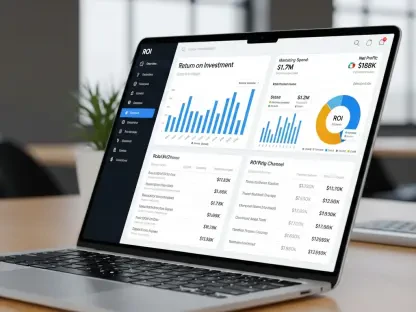Imagine a multinational corporation struggling with supplier payments, bogged down by manual processes, delayed reconciliations, and fragmented systems that drain time and resources, a scenario all too common in enterprise financial operations where inefficiencies can cost millions annually. Enter a transformative solution: the integration of Visa’s virtual card payment capabilities into Oracle ERP systems through a strategic partnership with KNEX. This review delves into the intricacies of the KNEX Visa Virtual Card Adapter, evaluating its features, performance potential, and impact on streamlining payment processes within widely used ERP platforms like Fusion Applications and NetSuite.
Core Features of the KNEX Visa Virtual Card Adapter
Seamless Payment Functionality
The KNEX Visa Virtual Card Adapter stands out for its ability to facilitate instant virtual card payments to vendors directly within the Oracle ERP environment. This eliminates the need for external banking applications, a common bottleneck in traditional payment workflows. By embedding payment functionality into the ERP system, the adapter simplifies transactions, allowing businesses to execute payments with just a few clicks.
Beyond ease of use, this integration significantly reduces manual effort. Finance teams no longer need to toggle between multiple platforms or handle cumbersome data entry, which often leads to errors. The result is a faster, more streamlined process that enhances operational speed and allows organizations to focus on strategic priorities rather than administrative tasks.
Automated Reconciliation and Security
Another critical feature of this adapter is its automated reconciliation capability. By ensuring that financial records remain synchronized between payments and invoices, the tool minimizes discrepancies that typically arise from manual interventions. This automation not only saves time but also boosts accuracy in financial reporting.
Security is equally prioritized in the adapter’s design. It provides secure access to invoice and payment data, reducing risks associated with unauthorized access or data breaches. Such robust security measures build trust in transactions, addressing a major concern for enterprises handling sensitive financial information across complex vendor networks.
Industry Trends Fueling Payment Modernization
The demand for integrated financial solutions within enterprise systems is surging, driven by a broader shift toward automation and digitalization. Businesses increasingly seek tools that unify disparate processes into cohesive platforms, eliminating silos that hinder efficiency. Visa and KNEX are at the forefront of this trend, embedding advanced payment technologies into Oracle ERP systems to meet modern enterprise needs.
Executives from both companies have underscored the importance of this shift. Basheer Khan, CEO of KNEX Technology, has highlighted how the collaboration prioritizes speed and intelligence in payment management. Similarly, Darren Parslow, Global Head of Visa Commercial Solutions, has emphasized the value of secure, native payment solutions in reducing manual workload and unlocking scalable efficiencies for organizations.
This partnership reflects a larger industry movement to modernize financial operations. By combining Visa’s expertise in digital payments with KNEX’s proficiency in Oracle integrations, the solution addresses long-standing challenges in supplier payments, setting a benchmark for how technology can transform enterprise workflows.
Real-World Applications and Impact
Industries reliant on Oracle ERP systems, such as manufacturing, retail, and services, stand to benefit immensely from the KNEX Visa Virtual Card Adapter. For large enterprises managing extensive vendor networks, the tool offers a way to simplify complex payment structures. This is particularly valuable in scenarios where timely payments are critical to maintaining supply chain stability.
Specific use cases demonstrate its potential impact. Consider a retail giant processing thousands of supplier invoices monthly; the adapter can automate payments and reconciliations, slashing processing times and minimizing errors. Such efficiency translates into tangible cost savings and stronger supplier relationships, as payments are executed promptly and accurately.
Scalability is another advantage for adopting businesses. As companies grow or expand into new markets, the adapter supports increased transaction volumes without requiring additional resources. This adaptability ensures that organizations can maintain operational agility while keeping costs under control, a crucial factor in competitive industries.
Challenges and Limitations in Adoption
Despite its promise, implementing the KNEX Visa Virtual Card Adapter is not without hurdles. Technical integration can pose challenges, especially for organizations with legacy systems or highly customized ERP setups. Aligning the adapter with existing infrastructure may require significant time and expertise, potentially delaying deployment for some businesses.
Regulatory and compliance issues also warrant attention. Virtual card payments must adhere to varying regional standards, which can complicate cross-border transactions. Ensuring compliance with local financial regulations is essential to avoid legal or operational setbacks, particularly for multinational corporations operating in diverse jurisdictions.
Visa and KNEX are actively working to mitigate these barriers. Through pilot programs launched this year and ongoing efforts to expand compatibility across the Oracle ERP ecosystem, both companies are addressing adoption challenges. These initiatives aim to refine the solution and ensure it meets the diverse needs of global enterprises.
Future Outlook for Virtual Card Integration
The launch of the Visa Adapter at Oracle AI World and AFP events this year marked a significant milestone, accompanied by a pilot program involving select clients and issuing banks. This initial rollout provides valuable feedback to enhance the tool’s functionality and user experience. Plans are already in place to broaden support for additional ERP platforms over the next few years, signaling a commitment to wider accessibility.
Looking ahead, the integration is poised to drive further innovation in financial operations. Potential developments include enhanced analytics for payment tracking and deeper integration with emerging technologies like artificial intelligence. Such advancements could offer predictive insights, helping businesses optimize cash flow and vendor management strategies.
The long-term impact of this technology on digital transformation is profound. By reshaping payment management trends, the adapter positions itself as a catalyst for enterprise modernization. Its role in fostering seamless, secure, and automated financial processes will likely influence how businesses approach operational efficiency in the coming years.
Final Thoughts and Recommendations
Reflecting on this evaluation, the collaboration between Visa and KNEX has delivered a groundbreaking tool with the KNEX Visa Virtual Card Adapter, setting a new standard for supplier payment processes within Oracle ERP systems. Its seamless functionality, automated reconciliation, and robust security address critical pain points that have plagued enterprises for years. The real-world applications showcase undeniable benefits in efficiency and scalability, despite certain adoption challenges.
Moving forward, organizations exploring this solution should prioritize assessing their ERP infrastructure to ensure compatibility and allocate resources for smooth integration. Engaging with Visa and KNEX during pilot phases could provide early access to tailored support and updates. Additionally, staying informed about regulatory shifts in virtual payments will be key to navigating compliance complexities.
As digital transformation accelerates, businesses must consider how such integrations align with long-term financial strategies. Evaluating the adapter’s evolving capabilities and potential expansions into other platforms could position enterprises to stay ahead in a rapidly changing landscape. This technology represents a pivotal step, and proactive adoption could unlock sustained competitive advantages.









